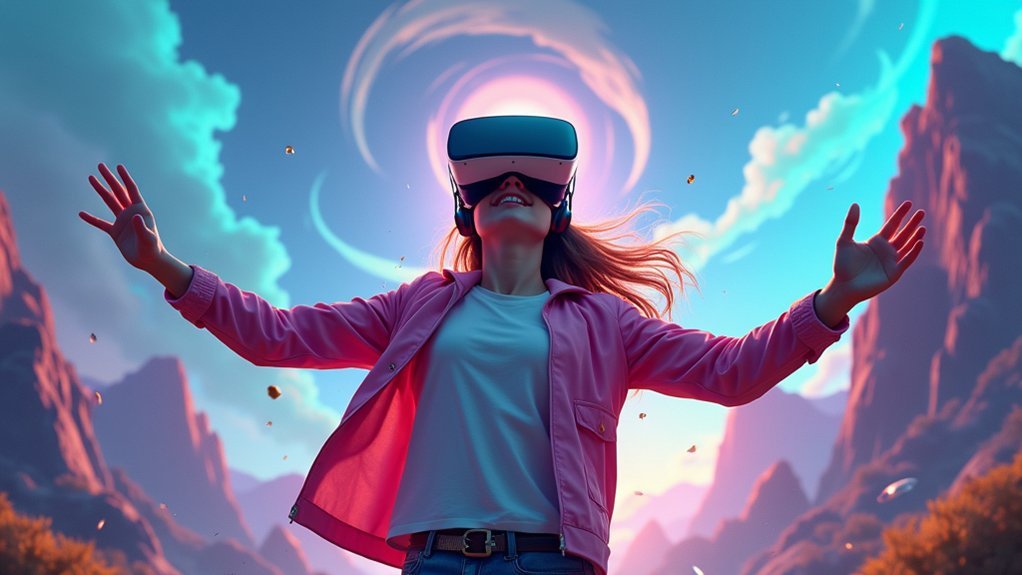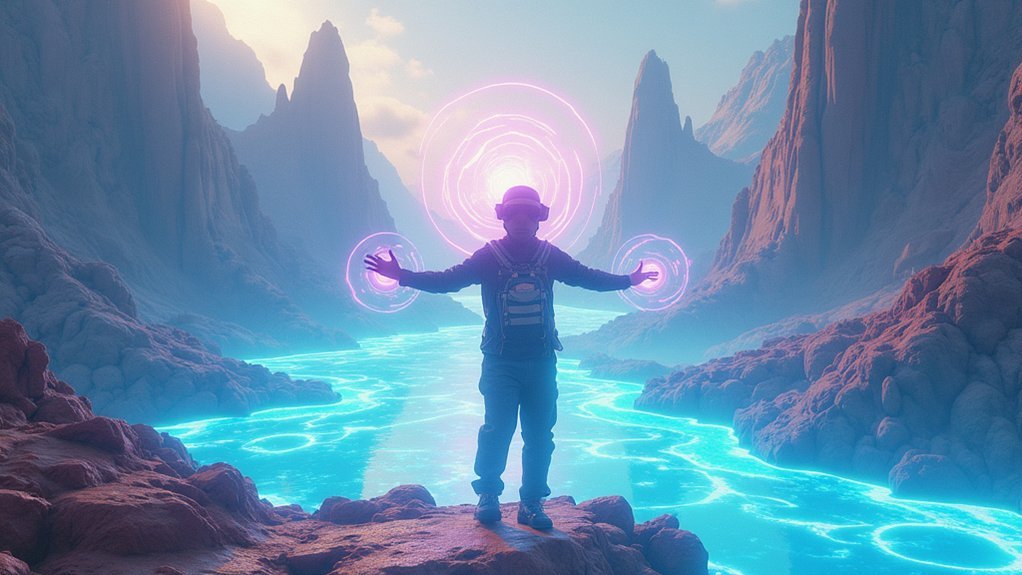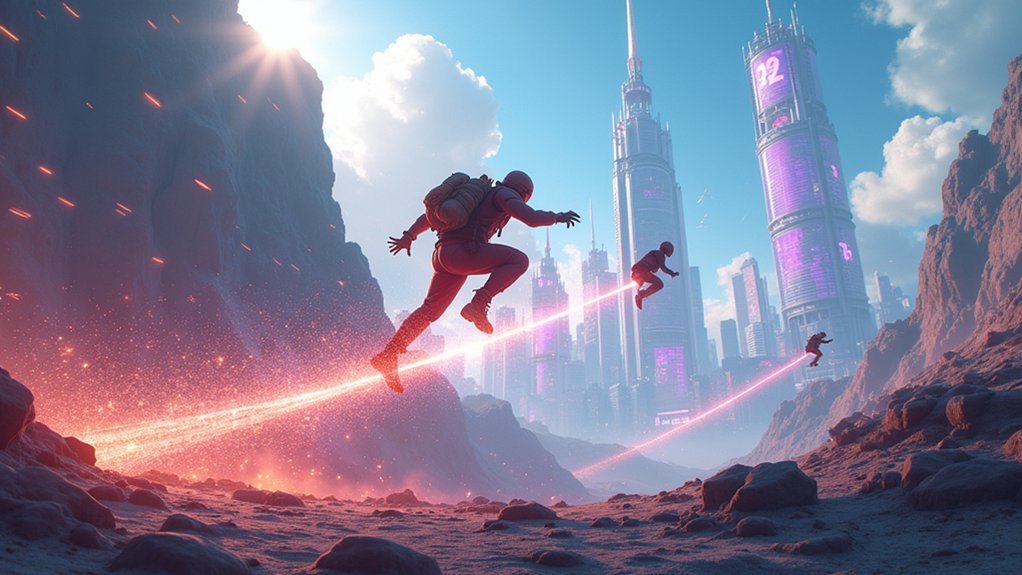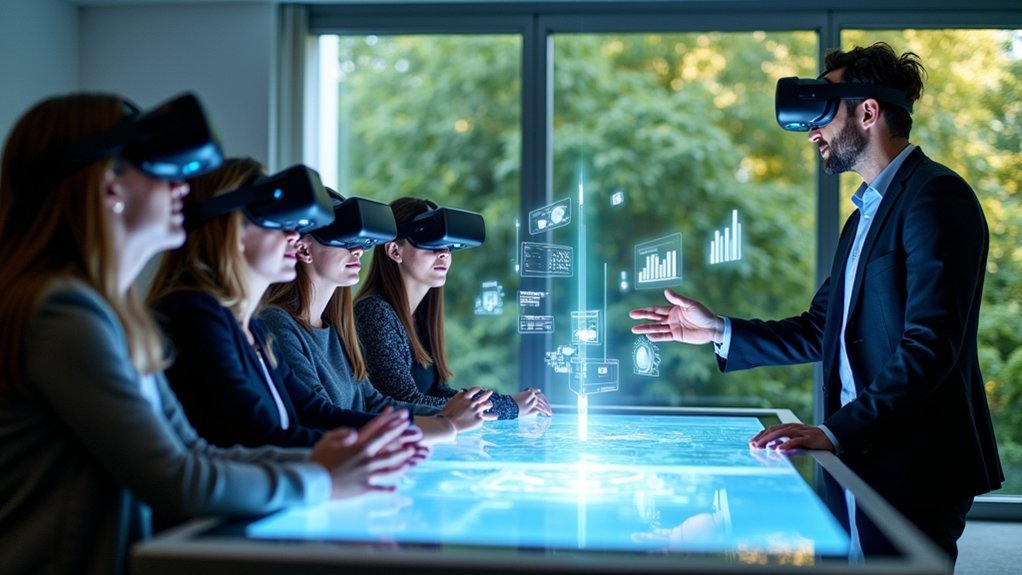You can replace teleportation with smooth locomotion using thumbsticks for continuous movement, snap-turning for instant rotation without motion sickness, or arm-swinging mechanics that mimic natural walking motions. Click-and-fly systems let you point and move instantly, while drag locomotion manipulates the world around you. Room-scale tracking enables real walking, step-based movement offers precise short-distance control, and hybrid dash systems combine multiple methods for maximum flexibility and comfort based on your preferences.
Smooth Locomotion for Continuous VR Movement

While teleportation offers a comfortable alternative, smooth locomotion stands as the gold standard for achieving true immersion in VR gaming.
You’ll control your movement using thumbsticks or touchpads, creating continuous navigation that feels natural and engaging. This VR locomotion method lets you explore expansive environments without jarring shifts.
However, smooth movement can trigger motion sickness if speeds don’t align with your physical movements. That’s why developers include comfort features like vignette effects and adjustable speeds to reduce nausea.
Games like “Pavlov” and “Onward” demonstrate effective implementation, allowing seamless navigation through complex environments.
Your preference ultimately depends on personal comfort levels. While some players embrace smooth movement for its immersive qualities, others stick with teleportation for easier, more comfortable gameplay.
Snap-Turning as a Comfort-First Alternative
When you’re experiencing motion sickness from smooth turning in VR, snap-turning offers an immediate solution by rotating your view in preset increments with a simple controller input.
This instant rotation mechanism eliminates the disorienting sensation of continuous movement while still allowing you to navigate effectively through virtual environments.
You’ll find that snap-turning prioritizes your comfort over visual fluidity, making it an essential option for extended gameplay sessions.
Instant Rotation Mechanics
How can VR developers address the discomfort that arises when players need to turn around but lack sufficient physical space? Instant rotation mechanics offer an elegant solution by allowing you to rotate your viewpoint in fixed increments with simple controller inputs.
Instead of smoothly turning your view, which can trigger motion sickness, snap-turning provides immediate directional changes that feel more natural to your inner ear.
This approach proves especially valuable in non-roomscale setups like PSVR, where you’re working with limited space.
You’ll find that combining snap-turning with smooth locomotion creates a comfortable hybrid system that reduces nausea while maintaining fluid movement.
Unlike teleportation, instant rotation mechanics preserve immersion by keeping you constantly present in the virtual environment without jarring shifts.
Player Comfort Considerations
Since motion sickness remains VR’s most notable barrier to widespread adoption, snap-turning emerges as a comfort-first solution that prioritizes player well-being over visual fidelity.
You’ll find this technique particularly valuable when you’re dealing with limited space, as it eliminates the need for physical rotation while maintaining effective navigation control.
When you combine snap-turning with smooth locomotion, you’ll experience considerably reduced disorientation and nausea. The predetermined angle rotations prevent the visual confusion that continuous turning often creates.
You can enhance this comfort further by implementing blink effects during rotation shifts, which minimize visual disruption.
Your personal preferences matter greatly here – while some players prefer smooth turning, others find snap-turning essential for comfortable gameplay.
These player comfort considerations make offering multiple locomotion options vital for inclusive VR design.
Arm-Swinging Mechanics for Natural Motion

Although traditional joystick controls remain popular, arm-swinging mechanics offer you a more natural approach to VR locomotion by translating your actual arm movements into virtual walking or running. This arm-swinging method mimics your natural motion patterns, creating enhanced immersion while potentially reducing motion sickness compared to other movement systems.
| Aspect | Arm-Swinging | Traditional Controls |
|---|---|---|
| Motion Sickness | Reduced risk | Higher potential |
| Physical Engagement | High activity level | Minimal movement |
| Spatial Awareness | Improved orientation | Limited feedback |
| User Fatigue | Can be tiring | Low effort required |
Games like “The Bellows” demonstrate how arm-swinging provides engaging alternatives to teleportation. This free movement approach lets you actively navigate virtual spaces, though some players prefer less physically demanding options, emphasizing the importance of multiple locomotion choices.
Click-and-Fly Movement Systems
While arm-swinging mechanics provide excellent physical engagement, click-and-fly movement systems offer you a different approach that prioritizes speed and accessibility over physical exertion.
These systems let you point to any location in the virtual environment and instantly move there with a single button press or controller trigger.
You’ll find click-and-fly more intuitive than traditional teleportation because it creates fluid shifts rather than jarring jumps. Visual cues and smooth animations maintain your sense of immersion while reducing disorientation during movement. This makes the experience feel natural and continuous within the game world.
Click-and-fly movement systems excel in exploration-focused environments where you need to navigate large areas quickly while maintaining presence in the virtual space, making them accessible for players of all skill levels.
Drag Locomotion and World Manipulation

When you use drag locomotion, you’re manipulating the world around you rather than moving through it directly, which creates a fundamentally different relationship with the virtual environment.
This approach greatly reduces motion sickness because you’re controlling the movement of your surroundings instead of experiencing traditional character-based locomotion that can trigger discomfort.
You’ll find that drag-based systems let you grab and pull the world toward you or push it away, making navigation feel more like handling a physical object than traveling through space.
World Movement Mechanics
Instead of moving your character through the virtual world, drag locomotion flips the script by letting you manipulate the environment itself, pulling and pushing the world around you to navigate through immersive spaces. This world movement approach maintains visual stability, reducing motion sickness while enhancing your sense of presence.
| Feature | Traditional Movement | Drag Locomotion |
|---|---|---|
| Control Method | Character moves forward | World moves around you |
| Motion Comfort | Can cause nausea | Reduces disorientation |
| Interaction Style | Limited environmental contact | Direct world manipulation |
You’ll grab, throw, and physically engage with objects while the environment responds to your gestures. The technique requires precise calibration of movement scale and speed to match your comfort expectations, creating realistic navigation that feels natural and immersive.
Motion Sickness Reduction
Because drag locomotion maintains your body as a stable reference point while the virtual world moves around you, it greatly reduces the sensory conflicts that trigger motion sickness in VR experiences.
When you grab and pull the environment to navigate, your brain receives consistent signals that align with your physical position, preventing the disorientation common with smooth locomotion.
This movement method keeps your spatial awareness intact by letting you control distance and direction through natural hand motions.
You’ll experience considerably less nausea compared to traditional VR movement systems because there’s no disconnect between what your eyes see and what your body feels.
Studies consistently show that players report greater comfort levels when using drag-based navigation, making extended gaming sessions more enjoyable and accessible.
Real Walking With Room-Scale Tracking
As you physically walk through your living room, room-scale tracking transforms those natural movements into virtual exploration, creating the most intuitive form of VR locomotion available today.
Room-scale tracking turns your living room into a virtual world, making VR movement feel completely natural and intuitive.
This locomotion system directly maps your real-world steps to in-game actions, making moving around feel completely natural.
Systems like the HTC Vive and Oculus Quest use external sensors or built-in cameras to track your position within a designated play area.
You’ll need at least 6.5 feet by 5 feet of space to experience seamless movement tracking that captures your full range of motion.
Since your physical movements match what you see in VR, you’ll experience noticeably less motion sickness.
This natural alignment between your body’s movement and visual feedback maintains your sense of balance and orientation, creating an engaging, instinctive gameplay experience.
Step-Based Short-Range Movement
Step-based movement breaks down locomotion into deliberate, short-distance increments that mirror how you naturally walk in confined spaces.
You’ll input multiple commands for longer distances, giving you precise control while reducing disorientation that smooth locomotion often causes. This method preserves your spatial awareness and maintains continuity within the virtual environment, creating a more engaging experience than traditional teleportation.
You’ll find that step-based movement alleviates motion sickness symptoms by providing familiar, natural traversal patterns.
Games implementing this system typically include visual cues and audio feedback that reinforce your movement direction and distance. The controlled, deliberate approach lets you navigate environments methodically, enhancing immersion while keeping you grounded in the virtual space through recognizable walking patterns.
Hybrid Dash Systems Combining Multiple Methods
While step-based movement excels at providing control and reducing disorientation, hybrid dash systems take a more flexible approach by combining teleportation with smooth locomotion elements.
You’ll dash instantly to a set distance, then seamlessly shift into continuous movement from that new position. This combination addresses motion sensitivity while maintaining dynamic gameplay flow.
Here’s what makes hybrid dash systems effective:
Hybrid dash systems blend instant teleportation with smooth movement, offering players flexible control while minimizing motion sickness triggers.
- Instant traversal – You can quickly cover short distances without the gradual acceleration that triggers motion sickness.
- Seamless shifts – Visual cues and animations make switching between dash and smooth movement feel natural.
- Player choice – You decide when to use each movement type based on your comfort level.
- Enhanced immersion – The system maintains engagement while accommodating diverse player preferences.
Frequently Asked Questions
How to Move in VR Without Teleporting?
You can move using directional locomotion with joysticks, real walking in tracked space, arm-swinging mechanics, dash teleportation for short bursts, or step locomotion that combines multiple movement inputs for smoother navigation.
What Common Movement Options Are Available in a Virtual Reality VR Experience?
You can choose from directional movement with joysticks, real walking within your play space, on-the-spot jogging, fixed on-rails movement for guided experiences, or dash teleportation for quick navigation bursts.
Does Half-Life Alyx Have Locomotion?
Yes, you’ll find Half-Life Alyx features smooth locomotion as its primary movement system. You can walk and run naturally through environments, though you’re also given teleportation and snap turning options for comfort.
Why Do VR Games Use Teleport?
VR games use teleportation because you’ll experience less motion sickness compared to continuous movement. It’s more comfortable, accessible, and lets you navigate precisely without disorientation, making VR enjoyable for broader audiences.





Leave a Reply